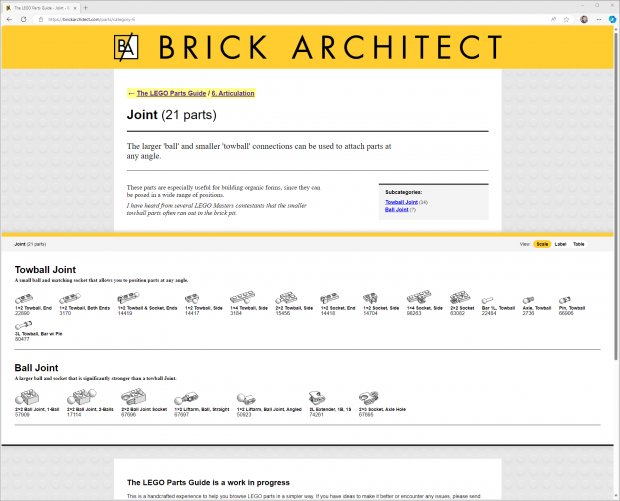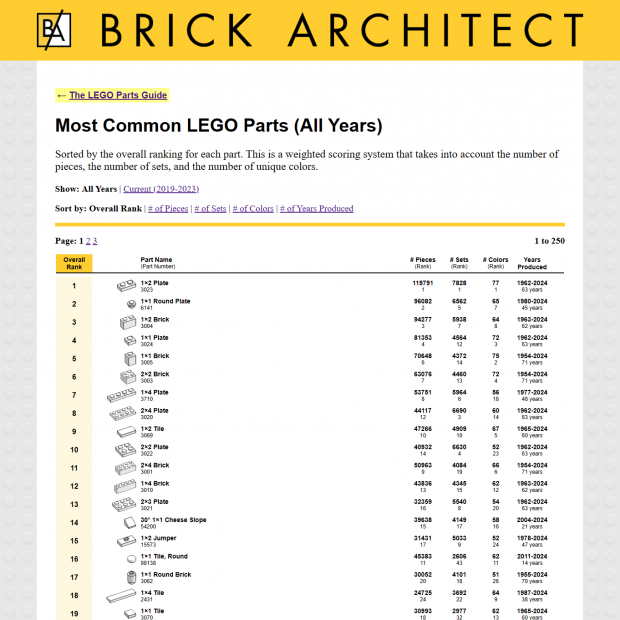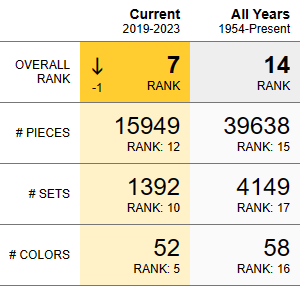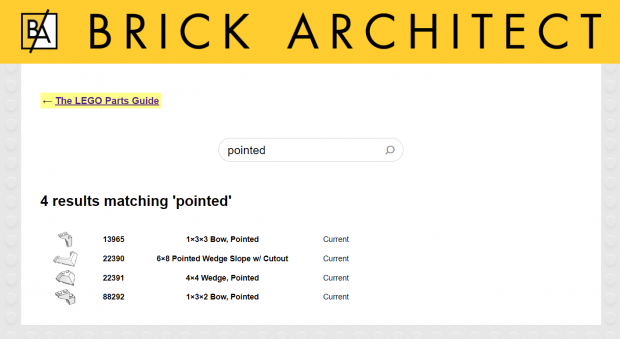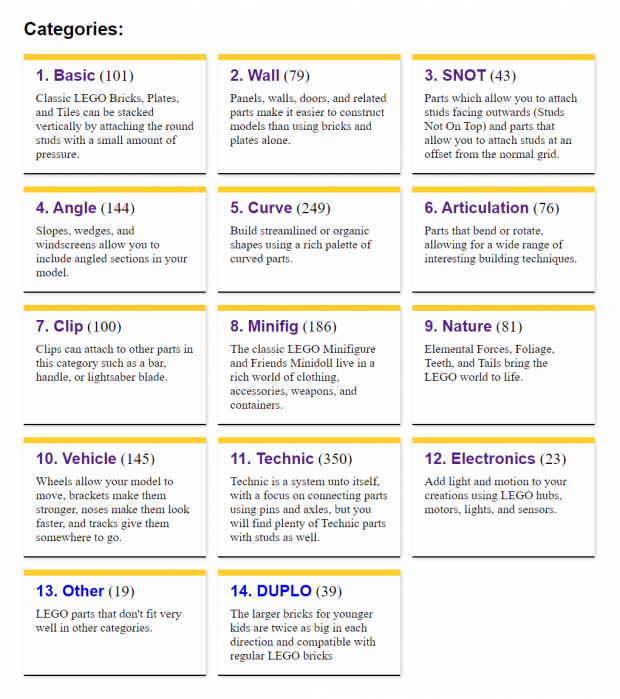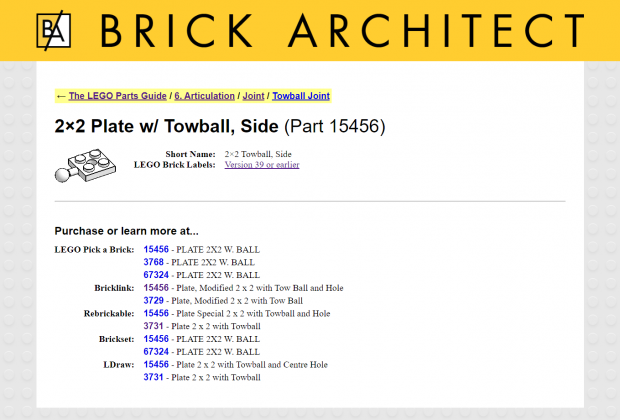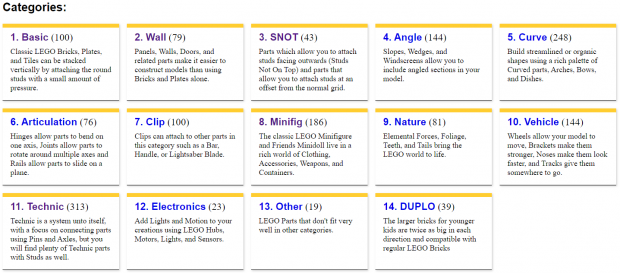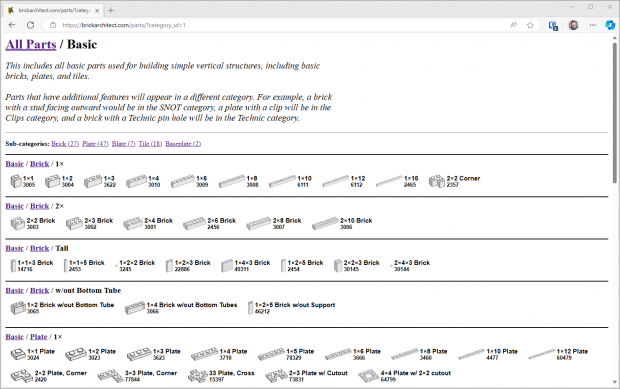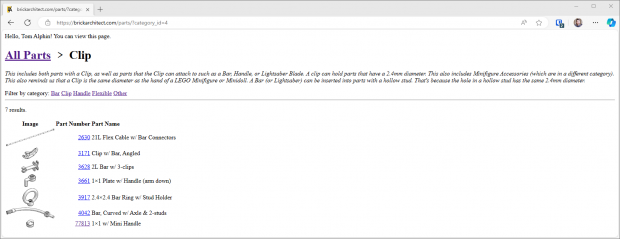About the LEGO Parts Guide
The LEGO Parts Guide was launched on February 21, 2024 after a month and a half of furious coding.
My motivation to create this guide was twofold:
- To give users easier access to the ‘Brick Architect’ way of sorting their collection. This hierarchal approach involves just 13 top-level categories which are easy to learn.
- As a foundation for future growth of the LEGO Brick Labels collection. The existing collection is collated manually, which is unsustainable given the size of the label collection.
The need for an online sorting guide came as a bit of a surprise to me. In recent years, I have heard from more and more LEGO enthusiasts that do not use my LEGO Brick Labels, but use a printed copy of the Contact Sheet as a sorting guide.
After sharing an early first version of the online sorting guide with a preview audience, I discovered the experience is appealing to a third audience as well — people who want to learn more about how LEGO works!
To better meet the needs of this audience, I spent a lot of time adding a subtitle for every category/folder in the hierarchy explaining which parts are in that category. Many categories also have a detailed description containing a few paragraphs of additional information about that type of LEGO part.
Support the LEGO Parts Guide
The LEGO Parts Guide grew out of my popular LEGO Brick Labels project. I want to thank all of the patrons who have supported these projects — you can see a full list of patrons on the LEGO Brick Labels page.
If you want to join them in showing your support, please visit patreon.com to subscribe!
Version History
The LEGO Parts Guide is comprised of two main parts: A handcrafted database containing all of the parts which I want to highlight in this guide (and a high quality image of each part). Users can access this database using a set of scripts that translate the data in the database into an easy-to-use web-based experience.
This version history highlights the most important changes to the Database and the Web Interface. It is not meant to be exhaustive, but rather to show how the experience has evolved over time.
-
June 29, 2024: Improvements to the New Parts page.
This is a small update to make it easier to highlight the new parts added every month. The New Parts page is now sorted by the date each part was added. It is possible to specify a custom date range, such as Parts added between 2024-06-01 and 2024-06-30.
-
April 8, 2024: Bugfixes & Improvements for very Small Screens.
I made a bunch of small refinements that fix minor issues in the previous update. The most noticeable change is that I have updated the pages to work on extremely small screens. (I have tested down to 320px wide – The browser width of the 2018 iPhone SE.)
-
April 4, 2024: Parts page improvements.
I’ve improved the overall appearance of the pages where you learn more about each part.

I cleaned up the pages where you learn more about each part. (This is an example showing a retired part.)
Recent Changes:
- Parts Page: Links to learn more about part on External Sites updated to use a tabular style and smaller text.
- Parts Page: Table showing ranking for retired parts updated to align better on large displays.
- Parts Page: Explanatory text under the ranking table only shows text that is relevant to the current part.
- Parts Page: Link to LEGO Brick Labels updated to use a conversational style.
- Parts Page: Fixed issue where page would not load for parts which retired in 2018.
- Parts Page: Show Date Added and Date Modified at the bottom of the Parts Page.
-
April 2, 2024: New Parts!
I’ve added around 90 parts to the guide after the initial launch in February. Most of these parts were added because they are common parts in either the all-time or current views. This includes a lot of parts which are ‘retired’ because they have not been produced in the past 5 years.
I created a simple page where people can see all of the new parts at: New parts since 2/21/2024.
Note: Retired parts are not visible in the Parts Guide but are visible in the lists of most common parts.
-
March 24-25, 2024: Minor improvements.
- Parts Homepage: Added a section with links to the Most Common Parts Guide above the section showing the top-level categories.
- Parts Page: Updated the arrows showing when parts are increasing or decreasing in popularity over time. (I was using Emoji in the original implementation, but this was not displaying correctly on mobile browsers so I switched to custom inline SVG graphics.)
- Most Common Parts Page: Added an explanation about the difference between ‘Most Common’ and ‘All Years’.
- Most Common Parts Page: Made “Current” the default view instead of All Years. (It is the most useful view for most users.)
- Parts Database: Added a few dozen parts to the database, allowing me to show an additional page of parts in Current – Overall Rank, Current – # Pieces, Current – # Sets, All-Years – Overall Rank, and All-Years – # Pieces. (Retired Parts was not a high priority for my LEGO Brick Labels collection, so I will need to add a lot of retired parts to the database before I can show additional pages of results in the ‘All-Years’ views.)
-
March 22, 2024: Most Common Parts Integration.
I launched a completely new feature under the LEGO Parts Guide umbrella… I’ve re-created my Most Common Parts Analysis using this updated data source.
The new experience lets you switch between seeing the “Current” parts (based on sets from past 5 years) and seeing ratings based on sets from all years (which is new). You can also sort this updated Most Common Parts Guide in several ways: by Overall Rank, by # of Pieces, # of Sets, # of Colors, and # of Years Produced.
The same information is visible when learning about a specific part. The top-line ranking is a weighted ranking that combines number of pieces, number of sets, and number of colors. The second column shows how the part ranks across The LEGO Group’s long history.
Other minor improvements:
- Other refinements to LEGO Parts page (including stylized treatment for retired/current/new).
-
February 25, 2024: Basic Search UX.
I have added the ability to search the LEGO Parts Guide. This was one of the top requests since launching the beta version about two weeks ago.
This is a very basic implementation which only searches the Brick Architect Part Number and Part Name. I will add the ability to search additional fields in the future.
Other minor improvements:
- Spelling and grammar fixes for several categories. (Thanks Laurie).
-
February 24, 2024: Years produced added.
I added the years that each part was produced to the page where you can learn more about each part.

Range of dates shown for each part. (Very old parts are not showing an accurate start date — 3005 should say 1954-2024.)
This date range is based on data from Brickset, which becomes less accurate going back to the 1990’s or earlier. As such, I am showing an * when a part might be even older. (I will switch to using Rebrickable data in the future.)
This also required that I complete a review of alternate Part ID’s across external sites (like Brickset). Most parts have been reviewed and now include alternate part numbers when applicable. (This also resulted in realizing that about 20 parts had retired, so they are now hidden until I decide to make a dedicated mode for seeing retired parts.)
-
February 21, 2024: Public Release!
After several weeks of testing by patrons and newsletter subscribers, I launched the site at https://brickarchitect.com/parts/
This update focused on compatibility on very large and very small screens, information to learn more and an option to subscribe to newsletter in the page footer.
-
February 19, 2024: Category Name and Description improvements.
Thorough review of Category Names, Subtitles, and Descriptions. I ensured that every category has a Subtitle, and edits for clarity and consistent capitalization.
-
February 18, 2024: URL Improvements.
I simplified the URLs for each part and category as follows:
- https://brickarchitect.com/parts/ – LEGO Parts Guide – Homepage
- https://brickarchitect.com/parts/3011 – Part #3011
- https://brickarchitect.com/parts/category-126 – Category #12 (Plants)
-
February 9, 2024: Initial data entry complete!
After a month of data entry, I finished adding (almost) every part that’s in the LEGO Brick Labels collection to the guide. There are some group parts which have not been added yet. ‘Retired’ parts are hidden until I have added enough of them to make it a useful addition to the LEGO Parts Guide. (Retired parts will remain hidden by default going forward, even when I add an option to show hidden parts.)
Fun Fact: The last category I added was Technic. It’s one of the most complex sections of the LEGO Parts Catalog, and I wanted to take my time and refine the sub-categories while adding all of the parts.
-
February 5, 2024: External part names & links!
I have imported the list of part names and numbers from the following LEGO Websites: Rebrickable (1/25), BrickLink (2/3), Brickset (2/3), and LDraw (2/5). This makes the page where you can learn about each part much more useful. (Brickset names are also used for LEGO Pick-A-Brick website).
This was implemented using an interstitial table that links the Part Number used on Brick Architect with the Part Number (or Numbers) used on other websites. This makes it possible for a single part on Brick Architect to link to multiple part variants on other sites.
The website assumes that the Part Number on Brick Architect matches the Part Number on other sites. This is usually true, so I only need to manually edit those parts where there are discrepancies.
-
January 30, 2024: Hover feedback on mouseover.
An elegant border is shown when hovering on each item in the gallery.
Fun Fact: The hover style matches each mode, with a rounded rectangle in ‘Scale’ mode mimicing how parts are shown in LEGO building instructions, and a rectangular rectangle in ‘Label’ mode matching how the labels look when printed and cut.
-
January 22, 2024: Category cards on homepage.
As I added more parts to the guide, it was taking too long for the gallery of parts to load. Instead of showing every part on the homepage, it now shows a rectangular card for each top-level category.
-
January 22, 2024: “Scale” view.
I had a rare moment of inspiration while going for a run, realizing that I could mimic the style that parts are shown in the back of an instruction booklet. This approach has the huge benefit of making it easier to see how large a part is at a glance.
-
January 10, 2024: “Label” view.
My first goal was to display parts in the same style as my LEGO Brick Labels collection. This has the advantage of showing a lot of parts in a small amount of space.
-
January 7, 2024: “Table” view.
After just a couple days of work, I was able to find parts recursively and display them as a simple table.
-
January 5, 2024: Coding begins!
Initial proof-of-concept to display a simple page from a SQL database. From there, I created the initial database structure allowing parts to be organized into a folder hierarchy — All data entry was manual at first.

